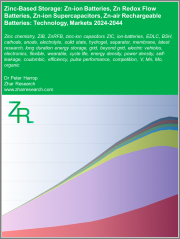
|
시장보고서
상품코드
1605390
레독스 플로우 배터리 시장 규모, 점유율, 성장 분석 : 재료별, 유형별, 스토리지별, 소유별, 용도별, 지역별 - 산업 예측(2024-2031년)Redox Flow Battery Market Size, Share, Growth Analysis, By Material (Vanadium, Zinc Bromine), By Type, By Storage, By Ownership, By Application, By Region - Industry Forecast 2024-2031 |
||||||
레독스 플로우 배터리 세계 시장 규모는 2022년에 2,093억 달러를 기록했으며, 2023년 2,558억 4,000만 달러에서 2031년에는 8,742억 달러로 성장하고, 예측기간 동안(2024-2031년) CAGR은 18.2%로 성장할 전망입니다.
세계 시장 환경은 에너지 산업의 잠재력을 강조하는 몇 가지 중요한 요인에 힘입어 큰 폭의 성장세를 보이고 있습니다. 재생에너지원의 통합과 전력망 현대화 노력이 주요 원동력이 되어 에너지 저장 솔루션에 대한 수요가 증가함에 따라 시장은 눈에 띄는 상승세를 보이고 있습니다. 이러한 추세에 따라 플로우 배터리는 확장성, 긴 사이클 수명, 빠른 응답 시간 등의 고유한 장점으로 인해 유틸리티 규모의 에너지 저장에 적합한 선택으로 자리매김하고 있습니다. 이러한 특성으로 인해 레독스 플로우 배터리는 특히 장기적인 전력 저장 솔루션이 필요한 애플리케이션에 매력적인 선택이 될 수 있습니다. 또한, 전해질 배합, 전극 재료 및 전반적인 시스템 설계의 개선을 포함한 레독스 플로우 배터리 기술의 지속적인 발전은 생산성을 높이고, 효율성을 개선하며, 비용을 크게 절감하는 데 도움이 되고 있습니다. 이러한 기술 혁신은 전 세계적으로 지속가능한 에너지 인프라로의 전환에 있어 레독스 플로우 배터리가 중요한 구성요소로 자리 잡으면서 시장 확대를 촉진할 것으로 예상됩니다. 전반적으로, 기술 발전과 효과적인 에너지 저장 솔루션에 대한 시급한 수요의 시너지 효과는 향후 몇 년 동안 레독스 플로우 배터리 시장의 유망한 전망을 보여주고 있습니다.
목차
소개
- 조사 목적
- 조사 범위
- 정의
조사 방법
- 정보 조달
- 2차 데이터와 1차 데이터 방법
- 시장 규모 예측
- 시장 가정과 제한
주요 요약
- 세계 시장 전망
- 공급과 수요 동향 분석
- 부문별 기회 분석
시장 역학과 전망
- 시장 개요
- 시장 규모
- 시장 역학
- 성장 촉진요인과 기회
- 성장 억제요인과 과제
- Porters 분석과 영향
- 경쟁 기업 간의 경쟁 관계
- 대체품의 위협
- 구매자의 교섭력
- 신규 참여업체의 위협
- 공급 기업의 교섭력
주요 시장 인사이트
- 핵심성공요인
- 경쟁 정도
- 주요 투자 기회
- 시장 생태계
- 기술의 진보
- 규제 상황
- 특허 분석
- 밸류체인 분석
- PESTEL 분석
- 시장 매력 지수
레독스 플로우 배터리 시장 규모 : 재료별 & CAGR(2024-2031)
- 시장 개요
- 바나듐
- 아연 브롬
- 기타
레독스 플로우 배터리 시장 규모 : 유형별 & CAGR(2024-2031)
- 시장 개요
- 바나듐 레독스 플로우 배터리
- 하이브리드 레독스 플로우 배터리
레독스 플로우 배터리 시장 규모 : 스토리지별 & CAGR(2024-2031)
- 시장 개요
- 소규모
- 대규모
레독스 플로우 배터리 시장 규모 : 소유별 & CAGR(2024-2031)
- 시장 개요
- 고객 소유
- 제3자 소유
- 유틸리티 소유
레독스 플로우 배터리 시장 규모 : 용도별 & CAGR(2024-2031)
- 시장 개요
- 유틸리티 서비스
- 재생에너지의 통합
- UPS
- 기타
레독스 플로우 배터리 시장 규모 : 지역별 & CAGR(2024-2031)
- 북미
- 미국
- 캐나다
- 유럽
- 영국
- 독일
- 스페인
- 프랑스
- 이탈리아
- 기타 유럽
- 아시아태평양
- 중국
- 인도
- 일본
- 한국
- 기타 아시아태평양
- 라틴아메리카
- 브라질
- 기타 라틴아메리카
- 중동 및 아프리카
- GCC 국가
- 남아프리카공화국
- 기타 중동 및 아프리카
경쟁 정보
- 상위 5개사의 비교
- 주요 기업의 시장 포지셔닝(2023년)
- 주요 시장 기업이 채용한 전략
- 시장의 최근 동향
- 기업의 시장 점유율 분석(2023년)
- 주요 기업 개요
- 기업 개요
- 제품 포트폴리오 분석
- 부문별 점유율 분석
- 매출 전년비 비교(2021-2023)
주요 기업 개요
- ESS Inc.(United States)
- Redox One(United States)
- WattJoule Corporation(United States)
- Invinity Energy Systems(United Kingdom)
- Largo Inc.(United States)
- Primus Power(United States)
- Sumitomo Electric Industries, Ltd.(Japan)
- Cell Cube(Enerox GmbH)(Austria)
- Redflow Ltd.(Australia)
- VRB Energy(Canada)
- Elestor(Netherlands)
- Jenabatteries GmbH(Germany)
- Lockheed Martin Corporation(United States)
- EverFlow(United States)
- Stryten Energy(United States)
- ViZn Energy Systems(United States)
결론과 추천사항
ksm 24.12.18Global Redox Flow Battery Market size was valued at USD 209.3 billion in 2022 and is poised to grow from USD 255.84 billion in 2023 to USD 874.2 billion by 2031, growing at a CAGR of 18.2% during the forecast period (2024-2031).
The global redox flow battery market is set for substantial growth, fueled by several key factors that underscore its potential in the energy landscape. With the rising demand for energy storage solutions, largely driven by the integration of renewable energy sources and efforts towards grid modernization, the market is witnessing a notable uptick. This trend has positioned flow batteries as a preferred choice for utility-scale energy storage, thanks to their inherent advantages, including scalability, extended cycle life, and rapid response times. These qualities make redox flow batteries particularly attractive for applications that necessitate substantial, long-term power storage solutions. Furthermore, ongoing advancements in redox flow battery technology-encompassing enhancements in electrolyte formulations, electrode materials, and overall system design-are instrumental in boosting productivity, improving efficiency, and generating significant cost savings. As these innovations continue to unfold, they are expected to drive market expansion, positioning redox flow batteries as a critical component in the transition towards sustainable energy infrastructures globally. Overall, the synergy between technological progress and the urgent need for effective energy storage solutions indicates a promising outlook for the redox flow battery market in the coming years.
Top-down and bottom-up approaches were used to estimate and validate the size of the Global Redox Flow Battery market and to estimate the size of various other dependent submarkets. The research methodology used to estimate the market size includes the following details: The key players in the market were identified through secondary research, and their market shares in the respective regions were determined through primary and secondary research. This entire procedure includes the study of the annual and financial reports of the top market players and extensive interviews for key insights from industry leaders such as CEOs, VPs, directors, and marketing executives. All percentage shares split, and breakdowns were determined using secondary sources and verified through Primary sources. All possible parameters that affect the markets covered in this research study have been accounted for, viewed in extensive detail, verified through primary research, and analyzed to get the final quantitative and qualitative data.
Global Redox Flow Battery Market Segmental Analysis
Global Redox Flow Battery Market is segmented by Materials, Type, Storage, Ownership, Application and Region. Based on Materials, the market is segmented into vanadium, zinc bromine, others. Based on Type, the market is segmented into vanadium redox flow battery, and hybrid redox flow battery. Based on Storage, the market is segmented into pharmacy Small-scale, and Large. Based on Ownership, the market is segmented into customer owned, third-party owned, utility owned. Based on Application, the market is segmented into utility services, renewable energy integration, ups, and others. Based on region, the market is segmented into North America, Europe, Asia Pacific, Latin America and Middle East & and Africa.
Driver of the Global Redox Flow Battery Market
The Global Redox Flow Battery market is experiencing significant growth fueled by the increasing integration of renewable energy sources like solar and wind power. As the world transitions towards cleaner energy alternatives, there is a rising demand for efficient energy storage solutions, with flow batteries emerging as a key player. These batteries not only enhance the utilization of renewable energy by allowing for better energy storage and delivery but also minimize disruptions in energy supply, thereby bolstering grid stability and reliability. This alignment between renewable energy generation and effective storage solutions is a critical driver of the redox flow battery market.
Restraints in the Global Redox Flow Battery Market
The Global Redox Flow Battery market faces significant restraints due to the high initial capital costs associated with these systems. Although there have been reductions in expenses, the substantial upfront investments required for installation can be a barrier to widespread adoption. This challenge is particularly pronounced in regions that lack sufficient financial incentives or legal frameworks to support energy storage initiatives. As a result, potential investors may hesitate to commit funds, slowing the growth and implementation of Redox Flow Battery technology in those markets, ultimately impacting the overall expansion of the sector.
Market Trends of the Global Redox Flow Battery Market
The Global Redox Flow Battery market is witnessing a significant trend towards the adoption of vanadium redox flow batteries (VRFBs), driven by their superior energy efficiency, extended cycle life, and lower maintenance needs. As vanadium prices decrease and production technologies become more streamlined, VRFBs are emerging as a competitive alternative to traditional battery systems. This evolution is particularly advantageous for energy storage and grid stabilization, making VRFBs increasingly popular in both developed and emerging markets. Consequently, the focus on sustainable and reliable energy solutions is propelling the growth of the VRFB segment, reshaping the landscape of the global battery storage industry.
Table of Contents
Introduction
- Objectives of the Study
- Scope of the Report
- Definitions
Research Methodology
- Information Procurement
- Secondary & Primary Data Methods
- Market Size Estimation
- Market Assumptions & Limitations
Executive Summary
- Global Market Outlook
- Supply & Demand Trend Analysis
- Segmental Opportunity Analysis
Market Dynamics & Outlook
- Market Overview
- Market Size
- Market Dynamics
- Driver & Opportunities
- Restraints & Challenges
- Porters Analysis & Impact
- Competitive rivalry
- Threat of substitute
- Bargaining power of buyers
- Threat of new entrants
- Bargaining power of suppliers
Key Market Insights
- Key Success Factors
- Degree of Competition
- Top Investment Pockets
- Market Ecosystem
- Technological Advancement
- Regulatory Landscape
- Patent Analysis
- Value Chain Analysis
- PESTEL Analysis
- Market Attractiveness Index
Global Redox Flow Battery Market Size by Material & CAGR (2024-2031)
- Market Overview
- Vanadium
- Zinc Bromine
- Others
Global Redox Flow Battery Market Size by Type & CAGR (2024-2031)
- Market Overview
- Vanadium Redox Flow Battery
- Hybrid Redox Flow Battery
Global Redox Flow Battery Market Size by Storage & CAGR (2024-2031)
- Market Overview
- Small-scale
- Large
Global Redox Flow Battery Market Size by Ownership & CAGR (2024-2031)
- Market Overview
- Customer owned
- Third-party owned
- Utility owned
Global Redox Flow Battery Market Size by Application & CAGR (2024-2031)
- Market Overview
- Utility Services
- Renewable Energy Integration
- UPS
- Others
Global Redox Flow Battery Market Size & CAGR (2024-2031)
- North America, (Materials, Type, Storage, Ownership, Application)
- US
- Canada
- Europe, (Materials, Type, Storage, Ownership, Application)
- UK
- Germany
- Spain
- France
- Italy
- Rest of Europe
- Asia-Pacific, (Materials, Type, Storage, Ownership, Application)
- China
- India
- Japan
- South Korea
- Rest of Asia Pacific
- Latin America, (Materials, Type, Storage, Ownership, Application)
- Brazil
- Rest of Latin America
- Middle East & Africa, (Materials, Type, Storage, Ownership, Application)
- GCC Countries
- South Africa
- Rest of Middle East & Africa
Competitive Intelligence
- Top 5 Player Comparison
- Market Positioning of Key Players, 2023
- Strategies Adopted by Key Market Players
- Recent Developments in the Market
- Company Market Share Analysis, 2023
- Company Profiles of All Key Players
- Company Details
- Product Portfolio Analysis
- Company's Segmental Share Analysis
- Revenue Y-O-Y Comparison (2021-2023)
Key Company Profiles
- ESS Inc. (United States)
- Company Overview
- Business Segment Overview
- Financial Updates
- Key Developments
- Redox One (United States)
- Company Overview
- Business Segment Overview
- Financial Updates
- Key Developments
- WattJoule Corporation (United States)
- Company Overview
- Business Segment Overview
- Financial Updates
- Key Developments
- Invinity Energy Systems (United Kingdom)
- Company Overview
- Business Segment Overview
- Financial Updates
- Key Developments
- Largo Inc. (United States)
- Company Overview
- Business Segment Overview
- Financial Updates
- Key Developments
- Primus Power (United States)
- Company Overview
- Business Segment Overview
- Financial Updates
- Key Developments
- Sumitomo Electric Industries, Ltd. (Japan)
- Company Overview
- Business Segment Overview
- Financial Updates
- Key Developments
- Cell Cube (Enerox GmbH) (Austria)
- Company Overview
- Business Segment Overview
- Financial Updates
- Key Developments
- Redflow Ltd. (Australia)
- Company Overview
- Business Segment Overview
- Financial Updates
- Key Developments
- VRB Energy (Canada)
- Company Overview
- Business Segment Overview
- Financial Updates
- Key Developments
- Elestor (Netherlands)
- Company Overview
- Business Segment Overview
- Financial Updates
- Key Developments
- Jenabatteries GmbH (Germany)
- Company Overview
- Business Segment Overview
- Financial Updates
- Key Developments
- Lockheed Martin Corporation (United States)
- Company Overview
- Business Segment Overview
- Financial Updates
- Key Developments
- EverFlow (United States)
- Company Overview
- Business Segment Overview
- Financial Updates
- Key Developments
- Stryten Energy (United States)
- Company Overview
- Business Segment Overview
- Financial Updates
- Key Developments
- ViZn Energy Systems (United States)
- Company Overview
- Business Segment Overview
- Financial Updates
- Key Developments



















